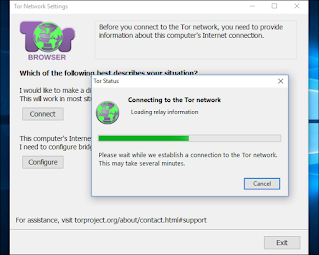Recently in my previous post, I talked about the "deep web", "Dark Web" and the "darknet". If you have not read the post, I strongly recommend you read it before continuing with this post, so as to give you a strong background of what a will be talking about in this post.
Website with “.onion” extension are not like normal domain names, and you can not access them with a normal web browser. Addresses that end with “.onion” point to Tor hidden services on the “deep web”.
Note: Many ".onion" websites contain very nasty things, and many of them are likely scams. I recommend staying away from “browsing” .onion sites–instead, use this only if you have a specific site you want to access for a good reason.
Understanding How ".onion Websites" Works
Tor (The Onion Router) is an anonymizing computer network. It has been reported that it’s partially funded by the US government, and is designed to help people in countries where Internet access may be censored or monitored. When you connect to Tor, your internet activity is sent through the Tor network, anonymizing your Internet activity so it can not be snooped on, and so that you can access websites that may be blocked in your country.So, when you access google.com through Tor, your request bounces from Tor relay to Tor relay before it reaches an “exit node”. That exit node then contacts Google.com for you, and it sends you back the data Google responded with. Google sees this as the exit node’s IP address contacting it instead of your IP address. But that means that “last mile” of traffic can be snooped on by an organization monitoring or even running the exit nodes especially if your traffic is unencrypted.
A “.onion” web address points to a Tor hidden service, which is a server you can only access through Tor. This means that your browsing activity can not be snooped on by someone watching the Tor exit nodes. It also means that someone hosting a website can hide that server using the Tor network, so no one can find it.
This allows you to access Facebook through Tor, and your connection doesn’t ever leave Tor where it can be snooped on. This may be useful in countries that block Facebook.
You don’t necessarily want to use Tor all the time, as it’s slower than just browsing normally. But it’s a useful tool for anonymizing your Internet activity and bypassing censorship.
This allows you to access Facebook through Tor, and your connection doesn’t ever leave Tor where it can be snooped on. This may be useful in countries that block Facebook.
You don’t necessarily want to use Tor all the time, as it’s slower than just browsing normally. But it’s a useful tool for anonymizing your Internet activity and bypassing censorship.
How to Access .onion Sites with the Tor Browser
To access a .onion web address, you will need to access it through the Tor Browser. It’s a modified version of Firefox that’s configured to connect to sites through the Tor network.Things You Will Need To Access .onion websites Via Tor Browser
- Download the Tor Browser from the Tor project’s website to continue. It’s available for Windows, Mac, and Linux.
- On Android phones and tablets, you can download the official Orbot proxy app or Orfox browser from Google Play. The Tor project offers no official Tor apps for iPhone or iPad.
- After launching the Tor browser, type the .onion address into its address bar. For example, to access Facebook’s hidden service,
- enter the following address:
Or,
to access the DuckDuckGo search engine’s hidden service,
While using the Tor browser, you can click links to .onion addresses and they will load normally. But they will only work in the Tor browser, while connected to Tor.
Don’t Access .onion Sites Through Proxies Like Tor2Web
You can also access .onion sites without running Tor through proxies that connect to Tor for you. The proxy connects to Tor for you and then forwards you the traffic over the regular Internet.
This, however, is a very bad idea! You are losing the anonymity you normally have when you connect to a .onion site through the Tor browser. That’s the whole point of a .onion address, after all. The website you access maintains its anonymity, but someone monitoring your connection can see which website you’re connecting to. The service provider can also see what you are connecting to and snoop on any passwords and other private information you provide over the connection.




